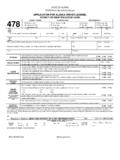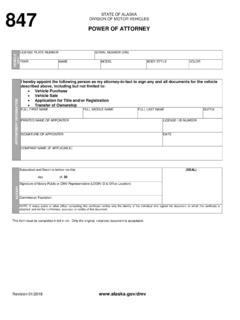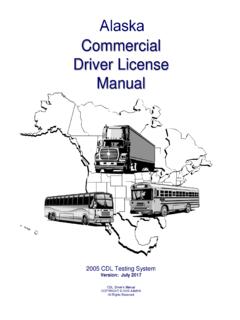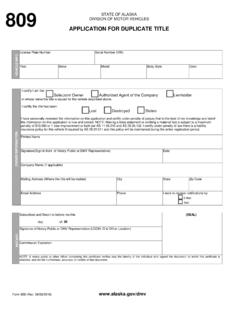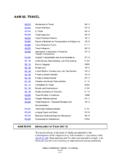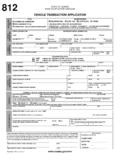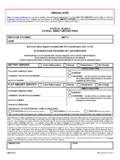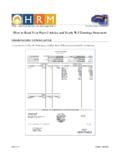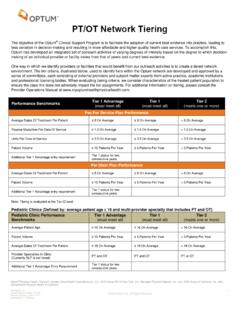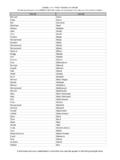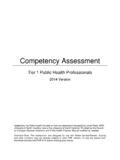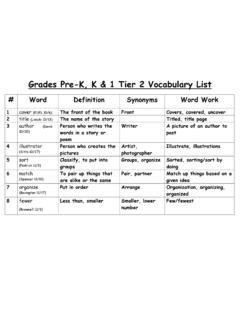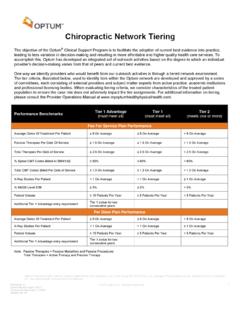Transcription of Alaska Division of Retirement and Benefits Public ...
1 More detailed information may be found on the Division website, , or in the PERS Information Handbook. G:/publications/handbooks/pers tier i-iv (Rev. 5/12/10) Alaska Division of Retirement and Benefits Public Employees Retirement System (PERS) Plan Comparison Chart Feature Tier I 1/1/1961 6/30/1986 Tier II Entered after 6/30/1986 Tier III Entered after 6/30/1996 Tier IV Entered after 6/30/2006 Employee Contribution (% of pay) Pre-tax employee contribution: beginning 1/1/87 all others beginning 1/1/87 police and fire beginning 7/1/99 school district Pre-tax employee contribution: beginning 1/1/87 all others beginning 1/1/87 police and fire beginning 7/1/99 school district Pre-tax employee contribution.
2 Beginning 1/1/87 all others beginning 1/1/87 police and fire beginning 7/1/99 school district Pre-tax employee contribution: 8% Employer Contribution (% of payroll) 22% Cost Share PERS on-behalf payment paid by the State of Alaska is 22% Cost Share PERS on-behalf payment paid by the State of Alaska is 22% Cost Share PERS on-behalf payment paid by the State of Alaska is 5% DCR Plan Account Health Plan - adjusted by annual actuarial valuation; plus Health Reimbursement Arrangement (HRA) - Flat dollar amount per employee based on 3% of the average annual compensation of all employees of all employers in the system. Occupational Death & Disability: - Police/Fire.
3 58% All others Vesting Employees vest with 5 years of service. Employees vest with 5 years of service. Employees vest with 5 years of service in the pension plan and with 10 years of service for the medical plan. 100% vested in employee contributions immediately. Vested in employer contributions based on the following schedule: 25% after 2 years of service, 50% after 3 years, 75% after 4 years and 100% after 5 years. Qualifications for Retirement After vesting, normal Retirement age is 55, with early Retirement at age 50; police/fire members can retire at any age after 20 years of police/fire service; all other members can retire at any age after 30 years of membership service. Early Retirement reduction will be 1/2% per month or 6% per year for every year less than the required normal Retirement age.
4 After vesting, normal Retirement age is 60, with early Retirement at age 55; police/fire members can retire at any age after 20 years of police/fire service; all other members can retire at any age after 30 years of membership service. Early Retirement reduction will be 1/2% per month or 6% per year for every year less than the required normal Retirement age. After vesting, normal Retirement age is 60, with early Retirement at age 55; police/fire members can retire at any age after 20 years of police/fire service; all other members can retire at any age after 30 years of membership service. Early Retirement reduction will be 1/2% per month or 6% per year for every year less than the required normal Retirement age.
5 None for investment account. Taxes and penalties may apply if withdrawn before age 59-1/2. See requirements for Retirement Medical Coverage. Benefit Calculation Formula Benefit formula: 2% for first 10 years and all years of service prior to July 1, 1986, for the next 10 years, and per year thereafter. Benefit calculation is determined on the average of the high three consecutive years salary. Police/Fire - 2% X 10, over 10. Benefit formula: 2% for first 10 years, for the next 10 years, and per year thereafter. Benefit calculation is determined on the average of the high three consecutive years salary. Police/Fire - 2% X 10, over 10. Benefit formulas did not change. However, the benefit calculation is determined on the average of the high five consecutive years salary.
6 The benefit calculation for police and fire members is the average of the high three consecutive years regardless of tier (effective 2002). DCR Plan account balance plus investment earnings. May be received in several different payment options. Payout options include lump sum payments, rollovers to another qualified plan, or annuities. Annuities may be taken as a lifetime annuity, joint and survivor annuity, or for a period certain. More detailed information may be found on the Division website, , or in the PERS Information Handbook. G:/publications/handbooks/pers tier i-iv (Rev. 5/12/10) Feature Tier I 1/1/1961 6/30/1986 Tier II Entered after 6/30/1986 Tier III Entered after 6/30/1996 Tier IV Entered after 6/30/2006 Alaska Cost-of-living Allowance (COLA) An Alaska Cost-of-Living Allowance is payable to benefit recipients who remain domiciled in Alaska after Retirement .
7 The allowance is $50 or 10% of the base benefit, whichever is greater. An Alaska Cost-of-Living Allowance is payable to benefit recipients age 65 or older or disability benefit recipients regardless of age who remain domiciled in Alaska after Retirement . The allowance is $50 or 10% of the base benefit, whichever is greater. An Alaska Cost-of-Living Allowance is payable to benefit recipients age 65 or older or disability benefit recipients regardless of age who remain domiciled in Alaska after Retirement . The allowance is $50 or 10% of the base benefit, whichever is greater. None provided. Post Retirement Pension Adjustments (PRPA) (Inflation Protection) PRPA increases granted on an ad hoc basis.
8 If an ad hoc is not granted, Tier I employees must be age 60 or over or receiving Benefits for 5 years to qualify for the automatic PRPA. The automatic PRPA passed in 1986 applied to all members regardless of hire date. Automatic PRPA adjustments to disabled members, retirees age 60 and over, and those who have received Benefits for 5 years. Automatic PRPA adjustments to disabled members, retirees age 60 and over, and those who have received Benefits for 5 years. None provided. Retirement Medical Coverage After vesting, medical coverage is provided to all benefit recipients and their eligible dependents. The Retirement system pays the AlaskaCare retiree medical plan premium. After vesting, medical coverage is provided to disabilitants, regardless of age, and benefit recipients age 60 and over or, Peace officer/fire members with 25 years of police/fire service all other members with 30 years of membership service This coverage includes eligible dependents.
9 The Retirement system pays the AlaskaCare retiree medical plan premium. Retirees and survivors under age 60 must pay the full premium cost if they want coverage. Same as Tier II. However, employees must accrue a minimum of 10 years of credited service*, to have system-paid coverage at age 60. Employees with less than 10 years must pay the full premiums as long as they wish to continue medical coverage. 100% vested with 10 years of credited service. *Credited service includes all service used in the calculation of a Retirement benefit. Access to medical coverage at Medicare eligible age with 10 years of service or at any age with 25 years of service for peace officers and firefighters or with 30 years of service for all others.
10 Must retire directly from the system. If not eligible for Medicare, must pay full premium. May use health reimbursement arrangement (HRA) account to pay premiums. Once the HRA is exhausted, member self-pays premiums. When eligible for Medicare, the percentage of premium paid by the retiree or surviving spouse is: 10-14 years of service - 30% 15-19 years - 25% 20-24 years - 20% 25-29 years - 15% 30 years or more - 10% Disability Benefits Nonoccupational disability Benefits are calculated as a normal Retirement . Occupational disability provides 40% of the gross monthly compensation. Different occupational disability formula available before 7/1/76. Nonoccupational disability Benefits are calculated as a normal Retirement .
